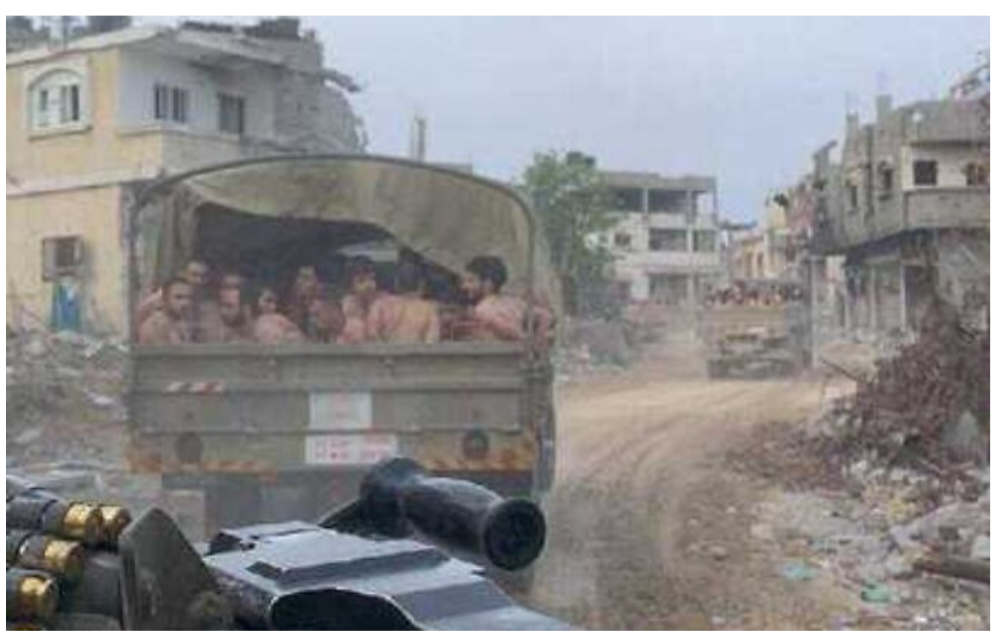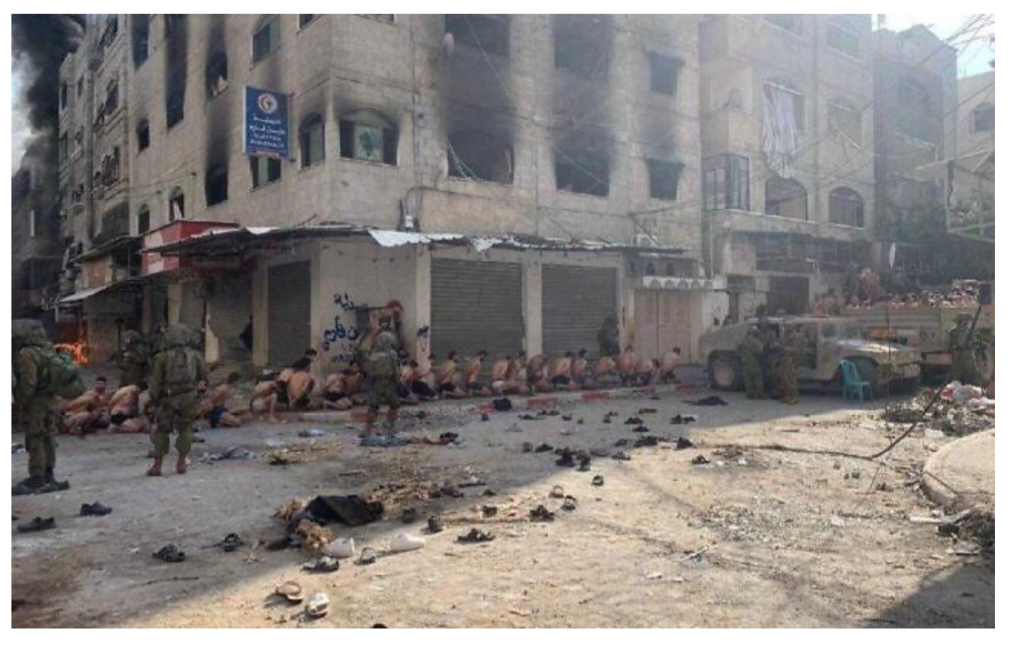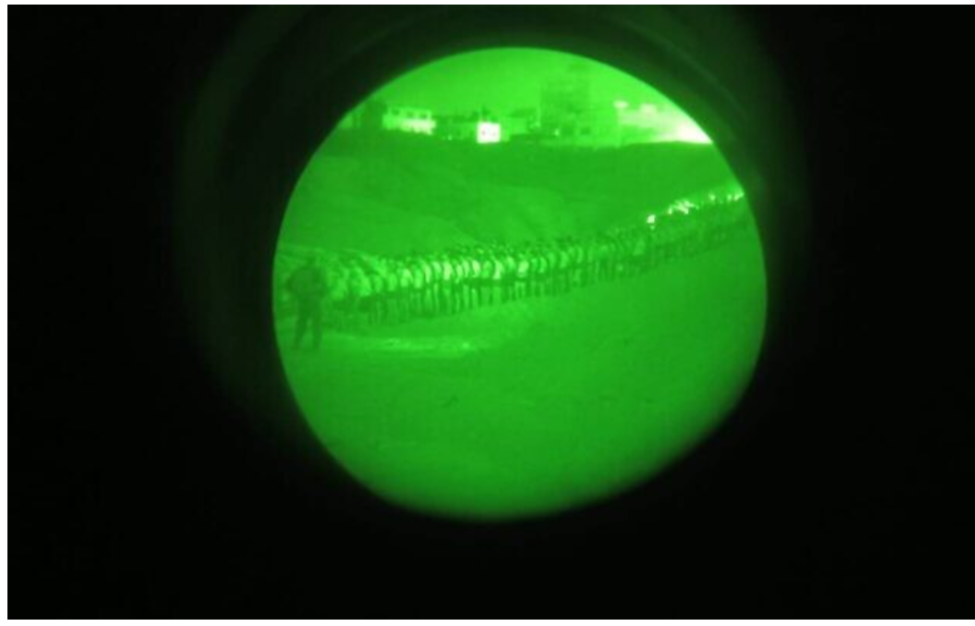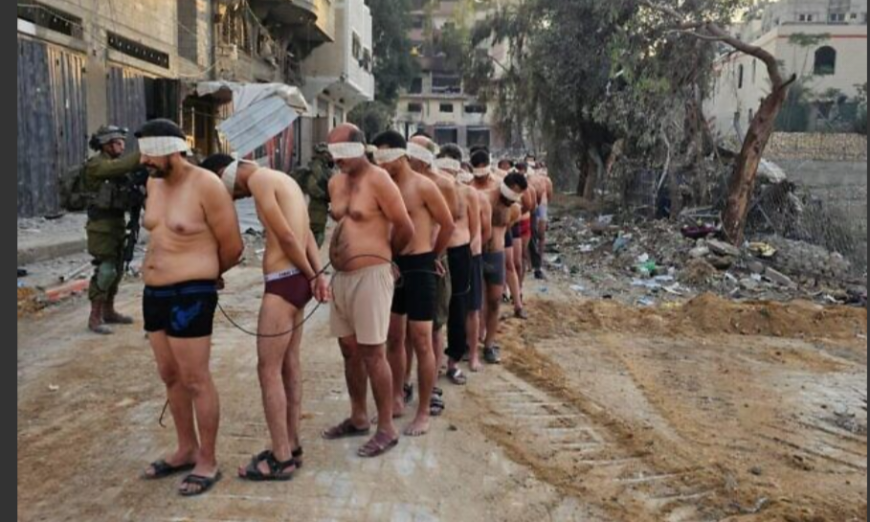Palestinian men surrender to troops in northern Gaza’s Jabaliya, on December 10, 2023. (Social media; used in accordance with Clause 27a of the Copyright Law.)
IDF says terror suspects searched to ensure they’re not wearing explosives belts, but that it hasn’t distributed pictures; national security adviser: they serve nobody’s interest.
Images of Palestinian men in Gaza being rounded up by troops and stripped to their underwear in recent days have sparked concerns about Israel’s arrest procedures in the enclave and questions over possible rights violations or humiliating treatment.
A number of pictures and videos that have leaked online in recent days show dozens of semi-naked Palestinian men being arrested. In some pictures, the detainees are being forced to sit or kneel on the ground in the open, sometimes blindfolded, while others show groups being marched with their hands in restraints or alleged fighters handing over weapons.
The Israeli military has confirmed arresting hundreds, claiming that Hamas members are surrendering in high numbers, as the terror group collapses under the army’s campaign to crush it.
But the military has also indicated that many of those it detained were later released, and officials have indicated that soldiers may be operating under a guideline of arrest first and question later.
On Sunday evening, Tzachi Hanegbi, Israel’s national security adviser, said suspects need to be searched to ensure they are not carrying weapons or explosives, but that the pictures of them in their underwear “serve nobody” and that he expected the distribution by Israel of such photos would cease.
IDF Spokesman Rear Adm. Daniel Hagari explained the arrest procedure in detail later Sunday, but also said the humiliating photos were not distributed by his office, and that troops would change the arrest procedure in cases where it was not being properly followed.
On Friday, Hagari said more than 200 “suspects” had been apprehended, but, of them, only “dozens” were transferred to the Shin Bet security agency and Military Intelligence Directorate’s Unit 504 for interrogation about their alleged involvement in terror activities.
Government spokesman Eylon Levy told CNN on Friday that Israel was detaining any military-aged men it found in areas where evacuations had been ordered — meaning all of north Gaza and parts of the south as well — “to work out who the terrorists are.”
“The people we’re seeing in these images are all suspected terrorists,” Levy said. “We wish that all Hamas fighters were wearing uniforms that clearly said Hamas on their helmets, because that would make them easier to identify them. But when Hamas [members] dress up as civilians, and fight within civilian areas, they make it very difficult to find them.”
According to Israel’s Channel 12 news on Sunday, some 700 people have been detained, 60 percent of whom have been determined to not be terrorists. Haaretz, citing the assessment of senior defense officials, reported that only 10-to-15% of the arrested men are thought to be affiliated with Hamas.
The Israel Defense Forces said in a statement to AFP on Sunday that troops in Gaza detain and question individuals suspected of involvement in “terrorist activity.”
“Individuals who are found not to be taking part in terrorist activities are released,” it added, saying that the detainees are treated in accordance with international law.
According to the IDF, people deemed a potential threat are stripped to ensure that they are not carrying weapons or explosives.
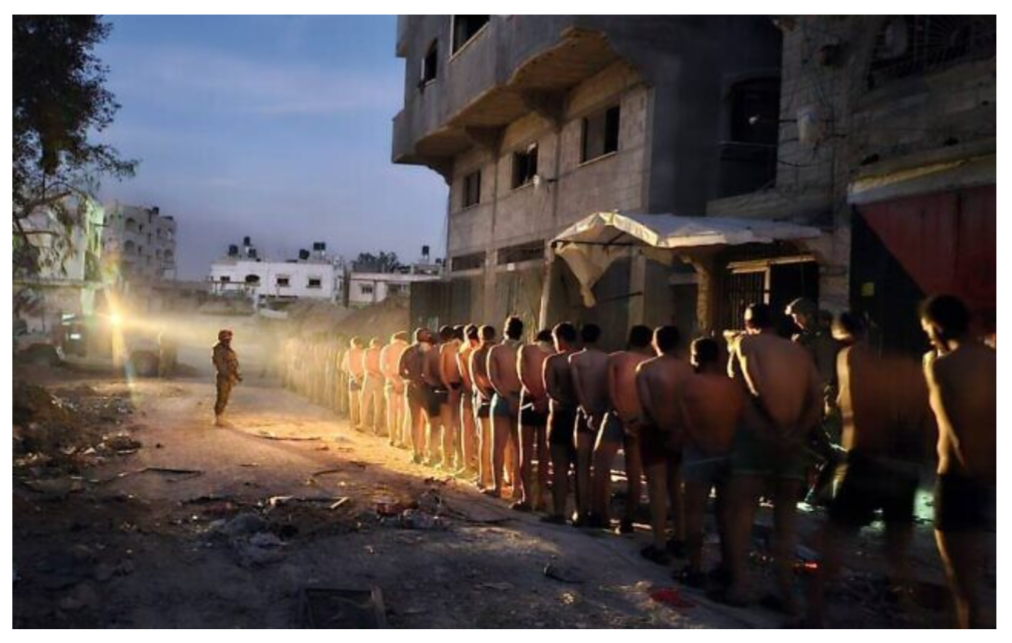
“The people we’re seeing in these images are all suspected terrorists,” Levy said. “We wish that all Hamas fighters were wearing uniforms that clearly said Hamas on their helmets, because that would make them easier to identify them. But when Hamas [members] dress up as civilians, and fight within civilian areas, they make it very difficult to find them.”
According to Israel’s Channel 12 news on Sunday, some 700 people have been detained, 60 percent of whom have been determined to not be terrorists. Haaretz, citing the assessment of senior defense officials, reported that only 10-to-15% of the arrested men are thought to be affiliated with Hamas.
The Israel Defense Forces said in a statement to AFP on Sunday that troops in Gaza detain and question individuals suspected of involvement in “terrorist activity.”
“Individuals who are found not to be taking part in terrorist activities are released,” it added, saying that the detainees are treated in accordance with international law.
According to the IDF, people deemed a potential threat are stripped to ensure that they are not carrying weapons or explosives.
“It is often necessary for terror suspects to hand over their clothes such that their clothes can be searched and to ensure that they are not concealing explosive vests or other weaponry,” the army told AFP.
Under the Geneva Conventions, it is unlawful to expose prisoners of war to “public curiosity,” in order to preserve their dignity and protect them from public identification and retribution. Some countries maintain that captured terrorists are not subject to protections under the accord.
The army did not initially comment on the origin of the footage, which began finding its way online Thursday. But at least some of the photos and videos show evidence of having been taken from army positions, and some have speculated that they were intentionally leaked as part of a campaign to break the morale of Hamas’s fighters.
In one instance, a man is seen surrendering weapons three different times, raising questions.
Speaking to Israel’s Kan broadcaster on Sunday evening, National Security Adviser Hanegbi confirmed that the pictures had been taken “with the necessary permission” of Israeli authorities but said that he disapproved of the practice.
“I think you won’t see more pictures like this from now on,” he said.
Hanegbi said it was essential to ensure arrested terror suspects were not carrying arms or explosives. “I hope there will be many more people who surrender without a fight and lay down their weapons, but they’ll be checked and then will dress. They don’t need to be taken [into custody] in the way seen in those first pictures,” he said.
Later Sunday, at his nightly press conference, IDF Spokesman Hagari explained the arrest procedures in more detail, and related to the photos. He said the pictures that had been circulating were taken in Jabaliya and Shejaiya, Hamas strongholds in northern Gaza where the IDF is still fighting. “Lots of terrorists” were being killed there, Hagari said, but “lots of people” were also emerging during the fighting, some of them surrendering and laying down their weapons.
Those surrendering are stripped as a precaution, “because we fear [they are wearing] explosives belts.” Over the years, he noted, “there have been instances when people have blown themselves up alongside our troops.”
The men are then questioned in the field, and Hamas members are often identified, while others, it becomes clear, are not members of terror groups. Once the questioning is over, “they put on their clothes. That is what needs to happen. Where it didn’t happen, we’ll change that,” he said.
The alleged terrorists are then brought to Israel for further investigation, Hagari said, while civilians are taken to safe areas in the south of the strip.
Israel launched its military campaign after thousands of Hamas fighters invaded the south of the country on October 7, rampaging through communities and killing some 1,200 people, most of them civilians, and taking another estimated 240 people hostage.
The IDF says it has killed 7,000 Hamas members or allied terrorists as it seeks to destroy the terror group, free the hostages and ensure such an attack can never occur again.
The photos have elicited visceral distaste and criticism from some. The International Committee of the Red Cross, which has come under pressure from Jerusalem over its muddled attempts to get access to Israelis held hostage in Gaza, expressed concern over the images.
“We strongly emphasize the importance of treating all those detained with humanity and dignity, in accordance with international humanitarian law,” an ICRC spokesperson said in a statement carried by Reuters.
Rep. Elise Slotkin, a Michigan Democrat with a long career in the CIA and Pentagon, said that she could not remember similar scenes coming out of Iraq, when the US faced a similar challenge there following its invasion in 2003.
“It’s part of this bigger conversation of how do you determine the difference between a civilian and a militant in an extremely crowded place,” she told CNN. “It’s one of the most difficult things to do, and therefore requires extreme care on the part of the military that’s launching these operations.”
Jordanian Foreign Minister Ayman Safadi claimed at a press conference Friday that some of those detained were doctors and journalists.
London-based Arabic language news outlet Al-Araby Al-Jadeed said on Thursday that, among those Palestinians stripped down to their underwear, was its reporter Diaa al-Kahlout and members of his family.
Some of those who were arrested and released told The Associated Press that they were treated badly, including being beaten and given little water.
Ahmad Nimr Salman alleged that older men with diabetes or high blood pressure were ignored when they asked soldiers to remove zip ties tightly wound around their wrists.
He said the troops asked, “‘Are you with Hamas?’ We say ‘no,’ then they would slap us or kick us.” He said his 17-year-old son Amjad was still being held by the troops.
The group was released after five days and told to walk south. Ten freed detainees arrived at a hospital in Deir al-Balah after flagging down an ambulance.
The Israeli military had no immediate comment when asked about the alleged abuse.
Hamas claimed the images did not show any members of the group’s armed wing being arrested.
“The occupation’s claims that they are from al-Qassam Brigades are unfounded lies,” said Izzat al-Rishq, a senior member of the Hamas political bureau. “The Zionist occupation published images and scenes of unarmed civilians in Gaza, after they were detained and weapons were placed next to them, which is nothing but a chapter out of the occupation’s ridiculous and obvious ploy to manufacture an alleged victory over the men of the resistance.”
